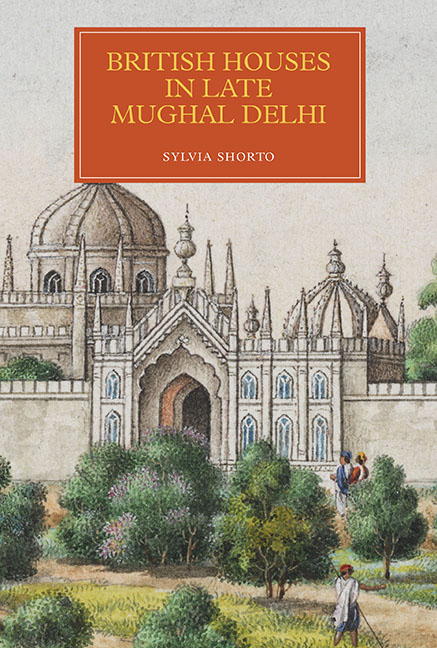Book contents
- Frontmatter
- Dedication
- Contents
- List of Illustrations
- Preface and Acknowledgements
- Abbreviations
- Glossary
- Map
- Chapter 1 Knowledge of Delhi: The Eighteenth Century
- Chapter 2 Hybrid Accommodations: David Ochterlony, the First Residency and the Mubarak Bagh
- Chapter 3 A Lovely Wilderness: Charles Metcalfe and the Garden Houses at Shalimar
- Chapter 4 Truly Fairy Palaces: Robert Smith in Delhi and in Europe
- Chapter 5 The World Displayed: William Fraser and his House on the Hill
- Chapter 6 A Tomb with View: Thomas Theophilus Metcalfe's Dilkusha
- Chapter 7 Dreaming of Home
- Bibliography
- Index
- Miscellaneous Endmatter
Chapter 4 - Truly Fairy Palaces: Robert Smith in Delhi and in Europe
Published online by Cambridge University Press: 07 July 2018
- Frontmatter
- Dedication
- Contents
- List of Illustrations
- Preface and Acknowledgements
- Abbreviations
- Glossary
- Map
- Chapter 1 Knowledge of Delhi: The Eighteenth Century
- Chapter 2 Hybrid Accommodations: David Ochterlony, the First Residency and the Mubarak Bagh
- Chapter 3 A Lovely Wilderness: Charles Metcalfe and the Garden Houses at Shalimar
- Chapter 4 Truly Fairy Palaces: Robert Smith in Delhi and in Europe
- Chapter 5 The World Displayed: William Fraser and his House on the Hill
- Chapter 6 A Tomb with View: Thomas Theophilus Metcalfe's Dilkusha
- Chapter 7 Dreaming of Home
- Bibliography
- Index
- Miscellaneous Endmatter
Summary
In Chapter Two I described how, at its inception in 1803, British settlement in Delhi was mainly concentrated in the elite area inside the Kashmir Gate of the walled city, to the north of the great Mughal fort/palace or Lal Qil'a, where the remains of the two most prestigious seventeenth-century Mughal riverine palaces were located. The Kashmir Gate area led out to rough open country beyond, where new British Civil and Military Lines would later be built. In this area stood the Residency house, as well as principal administrative offices including those of the judiciary, soon to be followed by a school, a printing press and a variety of new commercial establishments. The Residency itself had grown from a Mughal garden pavilion into an assertive hybrid structure, its new, colonnaded facade hiding a Mughal interior and proclaiming growing British authority over the city.
There was another large and visually arresting house in the Kashmir Gate area, this one built in the 1820s on top of older Mughal foundations (see Plate 6). Solidly constructed and still in use at the time of writing, the house occupied part of the remains of the second palace north of the fort, originally that of Ali Mardan Khan, the vazīr or principal minister of Shah Jahan. This chapter will focus on the activities of the man who built and lived in that house, Robert Smith (1787–1873), an officer in the Bengal Engineers, and on Smith's later and related building activities in Europe. The design of the house can be attributed on stylistic, documentary and circumstantial evidence to Smith, who was its occupant in the 1820s, the decade during which he served as Delhi's Garrison Engineer. Robert Smith is one of only two of my five subjects who did not die in India, returning to live a sumptuous if isolated life in hybrid houses he would design and build in Europe. It is the houses that Smith built after he left the Company's service that reinforce attribution to him of the Delhi house, as well as other Gothicising buildings in Delhi and elsewhere in north India.
Investigation of Robert Smith's house in Delhi has been hampered by two misconceptions in the secondary literature over the identity of its occupier.
- Type
- Chapter
- Information
- British Houses in Late Mughal Delhi , pp. 81 - 110Publisher: Boydell & BrewerPrint publication year: 2018

